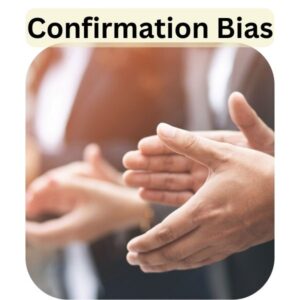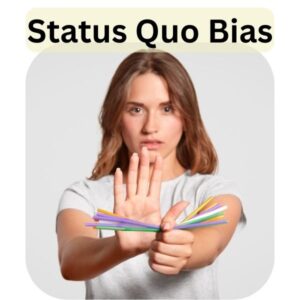Table of Contents
An Introduction to Cognitive Biases and How They Impact Our Decision-Making Process
Cognitive Bias Definition
A cognitive bias refers to the tendency of our minds to process information and make judgments in ways that are influenced by our beliefs, experiences, emotions, and other factors. These biases are shortcuts that our brains use to make decisions more quickly, but they can also lead to errors in judgment and decision-making.
Cognitive biases can impact many aspects of our lives, including our personal relationships, our work, and our financial decisions. Understanding cognitive biases is important because it can help us become more aware of our own thought patterns and improve our decision-making skills.
Our cognitive processes are prone to mental shortcuts or preconceptions, which are referred to as cognitive biases. These biases are heavily influenced by our beliefs, experiences, and emotions, and they can impact our decision-making negatively. Suboptimal outcomes are possible when we are unable to recognize and address these biases.
For instance, we might be guilty of confirmation bias, which leads us to seek out only information that reinforces our pre-existing beliefs. Alternatively, we could form an overall positive impression of a person or product based on a single positive attribute, a cognitive bias known as the halo effect.
By gaining an understanding of these biases and their effects on our decision-making, we can identify our own tendencies and develop strategies to overcome them. This could result in better decision-making and a greater likelihood of success in our personal and professional lives.
Cognitive Biases in Decision-making
Cognitive biases play a significant role in the decision-making process and can result in suboptimal choices. For example, confirmation bias can cause us to seek out information that supports our pre-existing beliefs, while the sunk cost fallacy can cause us to continue investing in a project simply because we have already invested resources into it.
By recognizing and addressing these biases, we can make more objective and informed decisions.
Cognitive Biases in Marketing
Cognitive biases also influence consumer behavior and marketing strategies. For instance, the anchoring effect can cause us to be influenced by the first piece of information we receive, while the scarcity effect can make us more interested in products that are perceived to be in limited supply. Marketers can take advantage of these biases to influence consumer behavior and increase sales.
Cognitive Biases in Investing
Cognitive biases can have a significant impact on investment decisions, potentially leading to poor performance. For example, the availability bias can cause investors to overweight recent news and events when making decisions, while the herd mentality can lead to groupthink and following the crowd.
By recognizing these biases and taking steps to avoid them, investors can make more informed decisions and potentially improve their investment outcomes.
Cognitive Biases in Behavioral Finance
Behavioral finance is a field of study that examines how cognitive biases and emotions impact financial decision-making. It recognizes that individuals are not always rational and can be influenced by factors such as mood and personality traits. By understanding these biases and their impact on decision-making, behavioral finance seeks to develop more effective investment strategies that account for these psychological factors.
Why Do We Need to Understand Cognitive Biases?
It is important to understand cognitive biases because they can have a significant impact on our decision-making and the outcomes that result from those decisions. These biases are natural and often automatic, meaning we may not even be aware of their influence on our thinking.
However, failing to recognize and address these biases can lead to missed opportunities, poor decision-making, and negative consequences. By understanding cognitive biases, we can become more aware of our own tendencies and develop strategies to overcome them.
This can lead to more informed and objective decision-making, improved problem-solving skills, and better outcomes overall. Additionally, understanding cognitive biases can also help us to be more empathetic and understanding of others, as we recognize that their biases may be influencing their actions and decisions as well.
Types of Cognitive Biases
Cognitive biases are errors in our thinking processes that can lead to incorrect judgments, decisions, and actions. There are many different types of cognitive biases, and they can occur in a variety of contexts, from everyday life to business and finance.
Some common types of cognitive biases include confirmation bias, which involves seeking out information that confirms pre-existing beliefs; anchoring bias, where a person relies too heavily on the first piece of information they receive; and availability bias, which occurs when we rely too heavily on readily available information when making decisions.
By understanding the different types of cognitive biases, we can become more aware of our own tendencies and take steps to avoid their negative impacts on our decision-making processes.
What is Self-Serving Bias

This bias might present itself in a variety of ways. Self-serving bias can be dangerous because it can lead to arrogance, overconfidence, and a lack of accountability.
Self-Serving Bias Example
Athletes may credit their success in a game to their own skill while attributing a defeat to variables beyond their control, such as terrible weather or a referee’s call. Similarly, a student may ascribe a good mark to their own hard effort, while a negative score may be attributed to a difficult exam or an unfair teacher.
What is Confirmation Bias?

This bias can be particularly insidious because it often operates at an unconscious level. People tend to seek out information that confirms their existing beliefs and ignore information that contradicts them, which can reinforce and entrench those beliefs even if they are incorrect. Confirmation bias can lead to narrow-mindedness, polarization, and a lack of critical thinking.
Example of Confirmation Bias
Someone who believes a political candidate is the best choice may only look for positive information about them and dismiss negative information. This can reinforce their beliefs and prevent them from seeing things objectively or considering alternative perspectives.
What is Anchoring Bias?
Anchoring bias is a cognitive bias that occurs when a person relies too heavily on the first piece of information they receive when making a decision or judgment, even if that information is irrelevant or incorrect.
This bias can be particularly powerful when the initial piece of information is striking or memorable. In general, anchoring bias can lead to a failure to consider alternative options or adjust one’s expectations based on new information.
Example of Anchoring Bias
A real estate agent might show a buyer a very expensive house first, in order to “anchor” their expectations and make a slightly less expensive house seem like a good deal by comparison.
Hindsight bias:
This bias can be especially problematic because it can lead people to believe that events were more predictable than they actually were. Hindsight bias can lead to overconfidence and a lack of humility, as well as a tendency to ignore the role of luck or chance in outcomes.
Example of Hindsight Bias
Someone might look back on a stock market crash and believe that they should have seen it coming, even though many experts were surprised by the severity of the downturn.
Availability Bias:
This bias occurs when people make judgments based on information that is readily available to them, rather than taking a more comprehensive approach.
Example of Availability Bias
Someone might assume that plane crashes are more common than car accidents because they are more widely reported in the media, even though car accidents are actually more frequent.
Framing bias:
The way that information is presented can have a significant impact on how people interpret it.
Example of Framing Bias
The same medical procedure might be perceived as more or less risky depending on whether it is presented in terms of the percentage of successful outcomes or the percentage of failures.
Fundamental attribution error:
The tendency to overestimate the role of personality or dispositional factors in explaining other people’s behavior, while underestimating the role of situational factors.
Example of Fundamental Attribution Error
A person may assume that someone who is unemployed must be lazy or unmotivated, rather than considering the possibility that they may have been affected by broader economic forces.
Stereotyping
The tendency to make assumptions about individuals based on their membership in a particular group. This can lead to discrimination and prejudice, and can also result in missed opportunities to learn from individuals who do not conform to stereotypes.
Halo effect
The halo effect is a cognitive bias that occurs when people attribute positive qualities to someone based on one positive trait or characteristic they possess.
Example of Halo Effect
If someone is physically attractive, people may assume they are also intelligent, kind, or successful.
Just-world bias:
The just-world bias is the tendency for people to believe that the world is inherently fair and that people get what they deserve. This bias can lead people to blame victims for their misfortunes, assuming that they must have done something to deserve their negative experiences.
Negativity bias:
The negativity bias is a cognitive bias that causes people to give more weight to negative information or experiences than positive ones. This bias can cause people to focus more on negative news stories, remember negative experiences more vividly, and give more weight to negative feedback than positive feedback.
Illusory superiority:
Illusory superiority, also known as the Dunning-Kruger effect, is a cognitive bias that causes people to overestimate their abilities or knowledge. This bias is often seen in people who are relatively inexperienced or unskilled in a particular domain, but who rate themselves as highly competent or knowledgeable.
False consensus effect:
The false consensus effect is a cognitive bias that causes people to overestimate the extent to which others share their beliefs or opinions. This bias can lead people to assume that their own views are more common than they actually are, and to be surprised or even offended when others disagree with them.
Groupthink:
Groupthink is a psychological phenomenon that occurs when a group of people prioritizes harmony and consensus over critical thinking and independent decision-making. In groupthink, individuals may suppress their own doubts or dissenting opinions in order to preserve group cohesion and maintain the illusion of unanimity.
Example of Groupthink
A group of coworkers who are tasked with developing a new project. Instead of engaging in open debate, the group may prioritize social harmony and agree to a proposal without fully considering alternative ideas.
False uniqueness effect
The false uniqueness effect is a cognitive bias that causes people to underestimate the extent to which others share their attitudes, beliefs, or behaviors. This bias can lead people to overestimate their own uniqueness or distinctiveness.
Example of False Uniqueness Effect
A person who believes they have a unique talent may be surprised to learn that many others share the same talent.
Actor-observer bias
The actor-observer bias is a cognitive bias that causes people to attribute their own behavior to external circumstances while attributing the behavior of others to internal characteristics or personality traits.
Example of Actor-Observer Bias
If someone is late to a meeting, they may attribute their lateness to traffic or a scheduling conflict, while assuming that someone else who is late is simply lazy or unreliable.
Egocentric bias
The egocentric bias is a cognitive bias that causes people to prioritize their own perspective over others. This bias can lead people to overestimate their own knowledge, abilities, or moral standing.
Example of Egocentric Bias
Politician assumes that their own beliefs and values are representative of those of their constituents, without considering alternative perspectives.
Endowment effect
The endowment effect is a cognitive bias that causes people to value things they own more highly than identical things that they do not own.
Example of Endowment effect
A person who owns a rare book may be reluctant to sell it for less than its perceived value, even if an identical copy is readily available for a lower price.
Status Quo Bias

The status quo bias is a cognitive bias that causes people to prefer things to remain the same rather than change. This bias can lead people to resist new ideas or initiatives, even when they might be beneficial.
Example of Status Quo Bias
An employee who resists a new software system at work, prefers to stick with the current system, even if the new system would improve efficiency.
Conformity bias
The conformity bias is a social bias that causes people to conform to the beliefs or behaviors of a group, rather than express their own independent judgment. This bias can lead people to make decisions that are not in their best interests or to remain silent in the face of injustice or wrongdoing.
Example of Conformity Bias
A group of friends who all adopt a particular fashion trend, even if it doesn’t suit their personal style.
The Barnum effect

The Barnum effect is a cognitive bias that causes people to believe that generalized, vague, or ambiguous statements about their personality or future are specifically about them. This bias is often exploited in fortune-telling or horoscopes, where individuals may identify with broad statements that are actually true for most people.
Example of Barnum Effect
If someone reads their horoscope and finds that it is full of vague predictions and advice, they may still believe that the horoscope accurately describes their personality or future.
Belief bias
Belief bias is a cognitive bias that causes people to evaluate the validity of arguments based on whether the conclusion aligns with their existing beliefs, rather than on the strength of the evidence.
Example of Belief bias
For example, if someone already believes that a particular medical treatment is effective, they may be more likely to accept an argument in favor of that treatment, even if the evidence supporting the argument is weak.
Bias blind spot
The bias blind spot is a cognitive bias that causes people to be unaware of their own biases while being able to recognize biases in others. This bias can make it difficult for people to identify and overcome their own biases.
Example of Bias blind spot
Someone who has a strong political bias may be unaware of their own biases, but be quick to point out the biases of people with opposing political views.
Curse of knowledge
The curse of knowledge is a cognitive bias that occurs when someone who is knowledgeable about a topic assumes that others share their level of knowledge. This can lead to difficulty in communicating complex ideas or concepts to those who are less knowledgeable.
Example of Curse of knowledge
For example, a professor who is an expert in their field may have difficulty explaining a concept to a student who is new to the subject.
False memory bias
False memory bias is a cognitive bias that causes people to remember events or experiences that never actually happened. This can occur when people are exposed to misleading information or when their memories are influenced by suggestions.
Example of False memory bias
For example, someone who is shown a doctored photograph of themselves as a child may develop a false memory of the event depicted in the photograph.
Illusory correlation
Illusory correlation is a cognitive bias that causes people to perceive a relationship between two variables when none actually exists. This can occur when people focus on coincidental or salient information and ignore information that contradicts the perceived relationship.
Example of Illusory correlation
For example, someone who believes that a certain astrological sign is associated with creativity may notice examples of creative people who share that sign, but ignore creative people who do not share the sign.
Illusion of Control
The illusion of control is a cognitive bias that causes people to overestimate their ability to control or influence events that are actually outside of their control. This can lead to feelings of undue optimism or pessimism and may result in unrealistic expectations.
Example of Illusion of Control
For example, a person who believes that they can control the outcome of a sporting event by wearing a lucky shirt is experiencing the illusion of control.
Mere-exposure effect
The mere-exposure effect is a cognitive bias that causes people to prefer things that are familiar to them. This effect can occur even if the person is not consciously aware of the exposure.
Example of Mere-exposure effect
For example, a person may develop a preference for a certain brand of soda simply because they have seen the logo many times.
Optimism bias
Optimism bias is a cognitive bias that causes people to overestimate the likelihood of positive events and underestimate the likelihood of negative events.
Example of Optimism bias
For example, a person may believe that they are less likely than others to experience a negative event, such as a car accident or a medical condition.
Pessimism bias
Pessimism bias is a cognitive bias that causes people to overestimate the likelihood of negative events and underestimate the likelihood of positive events.
Example of Pessimism bias
For example, a person may believe that they are more likely than others to experience a negative event, such as being the victim of a crime or experiencing a health problem.
Recency bias
Recency bias is a cognitive bias that causes people to place more importance on recent events or information than on older events or information. This can lead people to overestimate the significance of recent events or to forget important information that they learned in the past.
Example of Recency bias
For example, a person who reads a news article about a crime may be more likely to believe that crime is increasing in their area, even if overall crime rates have remained steady or decreased over time.
The Impact of Cognitive Biases in Business & the Workplace
Cognitive biases refer to our tendency to make errors in judgment and decision-making due to our mental shortcuts and preconceptions. These biases can have a significant impact on businesses and the workplace, affecting everything from hiring decisions to marketing strategies.
For example, confirmation bias, where we seek out information that supports our pre-existing beliefs, can lead to missed opportunities or poor decision-making. Similarly, anchoring bias, where we rely too heavily on the first piece of information we receive, can lead to inaccurate assessments and suboptimal outcomes.
By being aware of these biases and actively working to mitigate their effects, businesses and individuals can improve their decision-making and overall success.
Techniques & Strategies for Overcoming Cognitive Biases
Cognitive biases can negatively impact our decision-making abilities and prevent us from making informed choices. To overcome these biases, there are various techniques and strategies that we can use. One technique is to actively seek out alternative viewpoints and information that challenges our pre-existing beliefs.
This can help us to avoid confirmation bias and make more well-rounded decisions. Another strategy is to engage in reflective thinking, which involves taking a step back and critically analyzing our thoughts and assumptions. By questioning our own thought processes and challenging our biases, we can become more aware of our tendencies and make more objective decisions.
Additionally, collaborating with others and seeking diverse perspectives can help to mitigate the effects of cognitive biases and lead to more informed decision-making.
Conclusion
In conclusion, understanding our own cognitive biases is crucial to making better decisions. By acknowledging our biases and learning how they influence our thinking, we can develop strategies to overcome them. These strategies may include seeking out alternative viewpoints, engaging in reflective thinking, and collaborating with others to gain diverse perspectives.
By implementing these techniques, we can reduce the negative impact of cognitive biases on our decision-making and increase our ability to make informed choices. Ultimately, being aware of our own cognitive biases can lead to better outcomes in both our personal and professional lives, enabling us to navigate complex situations with greater ease and confidence.
You May Also Like
- NVS Staff Nurse Vacancy 2024 – How to Apply
- AIIMS NORCET 6 and ESIC Nursing Exam Questions and Answers
- ESIC Nursing Officer Recruitment 2024 | 1930 Vacancies – Apply Now
- Dream Job Alert: AIIMS NORCET Nursing Officer Vacancy 2024 – Apply Now!
- NIMHANS Nursing Officer Exam 17-12-2023 Memory-Based Solved Questions